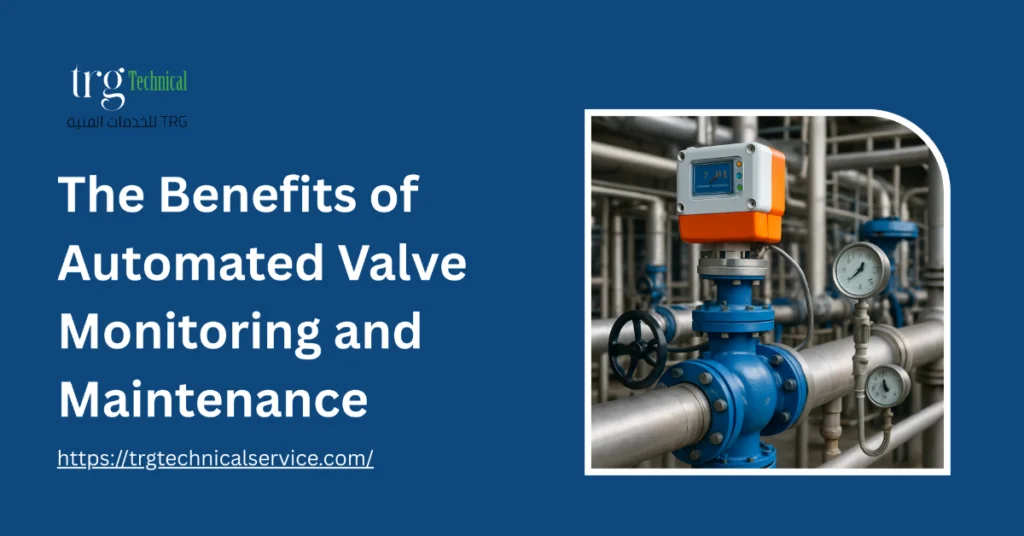The Benefits of Automated Valve Monitoring and Maintenance

In industries like oil and gas, water treatment, chemical processing, and power generation, valves play a critical role in controlling the flow of liquids, gases, and steam. A single valve failure can disrupt operations, cause safety hazards, and result in significant financial losses.
Traditionally, valve monitoring and maintenance have been manual, reactive processes. Technicians routinely inspect valves for leaks, pressure fluctuations, and wear. While this method works, it’s time-consuming, labor-intensive, and prone to human error.
Enter automated valve monitoring and maintenance a game-changing approach that leverages sensors, IoT (Internet of Things) technology, and predictive analytics to ensure valves remain in top condition while reducing downtime and operational costs.
In this article, we’ll explore the major benefits of automated valve monitoring and why forward-thinking industries are making the shift.
1. Real-Time Monitoring Reduces Unplanned Downtime
One of the biggest challenges with manual valve inspection is reactive maintenance. By the time a leak, pressure loss, or vibration is noticed, damage may already be done.
Automated valve monitoring solves this by:
Providing continuous real-time data on valve performance
Sending instant alerts when pressure, flow, or temperature readings are abnormal
Detecting leaks and malfunctions before they escalate
For example, in a refinery, an undetected valve leak can result in product loss and safety risks. Real-time monitoring allows operators to act immediately, reducing downtime and minimizing costly shutdowns.
2. Predictive Maintenance Saves Costs
Traditional valve maintenance often follows a fixed schedule — whether the valve needs attention or not. This approach can lead to:
Over-maintenance, wasting labor and resources
Under-maintenance, increasing the risk of failure
Automated systems use predictive maintenance, leveraging sensor data and historical performance trends to:
Identify wear patterns
Predict when a valve will likely fail
Schedule maintenance only when necessary
This condition-based approach lowers maintenance costs and extends valve life, providing a higher return on investment.
Read also: Top Signs That Your Valves Need Immediate Maintenance
3. Enhanced Safety for Personnel and Operations
Valves are often located in hazardous or hard-to-reach environments — such as chemical plants, offshore platforms, and high-temperature pipelines. Manual inspections expose workers to risks like:
Toxic gas leaks
Extreme heat or cold
High-pressure lines
Slips and falls in remote areas
By deploying automated monitoring systems, many inspections can be conducted remotely, reducing the need for workers to enter dangerous zones.
Additionally, early leak detection prevents accidents and environmental damage, ensuring compliance with safety regulations.
Read also: How to Troubleshoot and Repair Common Valve Problems
4. Better Regulatory Compliance and Reporting
Industries like oil, gas, and water treatment operate under strict regulatory frameworks. They are required to maintain detailed maintenance logs, inspection reports, and incident records.
Automated valve monitoring systems:
Automatically record performance data
Maintain digital maintenance logs for audits
Generate compliance-ready reports on demand
This streamlines reporting, reduces paperwork, and provides a verifiable maintenance history, which is critical during regulatory inspections.
Read also: How Valve Technology Is Evolving: Trends and Innovations
5. Extended Valve Lifespan and Asset Optimization
Valves that are monitored and maintained proactively last longer. Automated systems provide:
Early detection of issues like seal wear or stem friction
Insights into operational stress patterns
Recommendations for optimal maintenance intervals
By preventing excessive wear and avoiding catastrophic failures, automated monitoring extends the life of your valves and associated equipment, reducing capital expenditure over time.
Read also: How to Know When It’s Time to Replace a Valve in Your System
6. Optimized Resource Allocation
Manual valve maintenance often requires large inspection teams, frequent site visits, and unplanned overtime during emergencies. Automated monitoring:
Reduces the need for constant on-site inspections
Frees up skilled technicians for more critical tasks
Allows remote monitoring from control rooms or even cloud-based dashboards
This lean approach to resource allocation enhances efficiency and lowers operational costs without compromising reliability.
Read also: The Best Practices for Maintaining Different Types of Valves
7. Data-Driven Decision Making
Automated valve monitoring generates a continuous stream of data, which can be analyzed to:
Identify recurring maintenance issues
Compare performance across multiple sites or valve types
Support long-term asset management decisions
Over time, this data becomes a strategic asset, allowing companies to optimize equipment selection, improve maintenance planning, and reduce lifecycle costs.
8. Seamless Integration with Industrial IoT and SCADA Systems
Modern automated valve monitoring solutions are designed to integrate with existing plant infrastructure, including:
SCADA systems (Supervisory Control and Data Acquisition)
IoT networks for cloud-based analytics
Centralized asset management platforms
This seamless integration ensures that operators can monitor all critical equipment from a single dashboard, improving coordination and decision-making across the facility.
Read also: Why Valve Maintenance Is The Key to Industrial Success
9. Long-Term Cost Savings
While the initial investment in sensors, IoT devices, and automation software may seem high, the long-term benefits far outweigh the cost. Savings come from:
Reduced labor and inspection hours
Lower risk of catastrophic failures
Fewer production interruptions
Extended valve and equipment lifespan
Companies that adopt automated valve monitoring often recoup their investment quickly, especially in facilities where downtime costs thousands of dollars per hour.
Conclusion
Automated valve monitoring and maintenance represent the future of industrial reliability and efficiency. By reducing unplanned downtime, enhancing safety, and optimizing maintenance schedules, these systems transform reactive maintenance into proactive asset management.
For industries in oil and gas, water treatment, and manufacturing, this technology isn’t just a convenience it’s a competitive advantage and a safeguard for critical operations.
If you’re looking to implement advanced valve monitoring and industrial maintenance services, consider TRG Technical Services. Our team provides cutting-edge solutions to keep your operations running safely, efficiently, and without costly interruptions.


